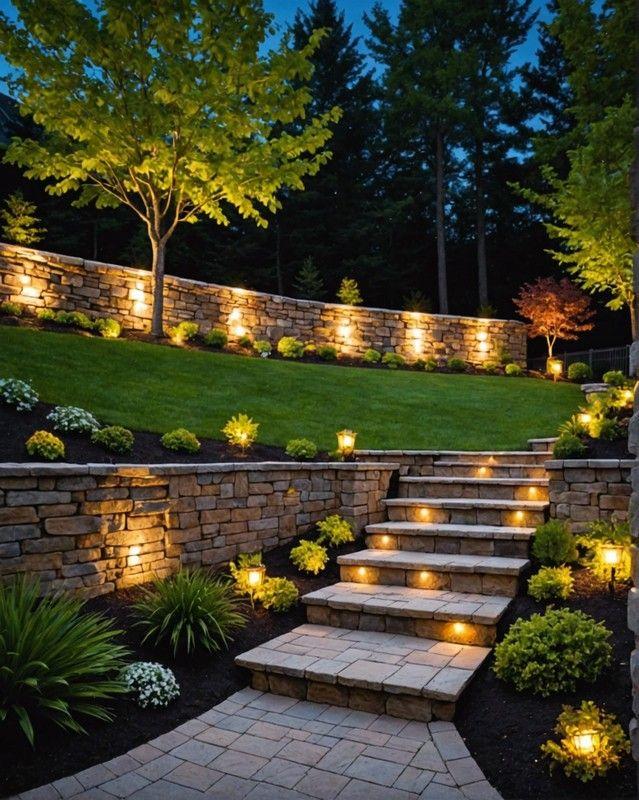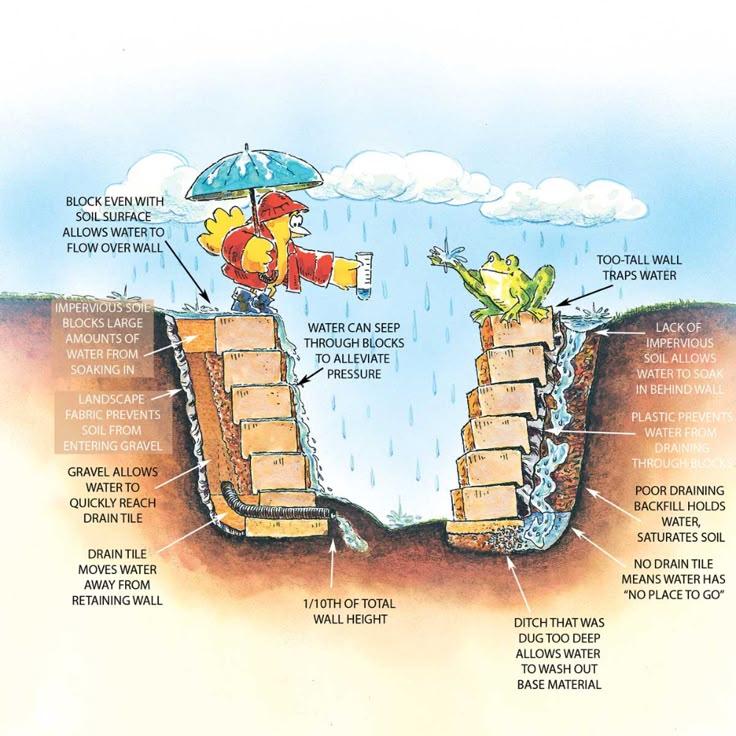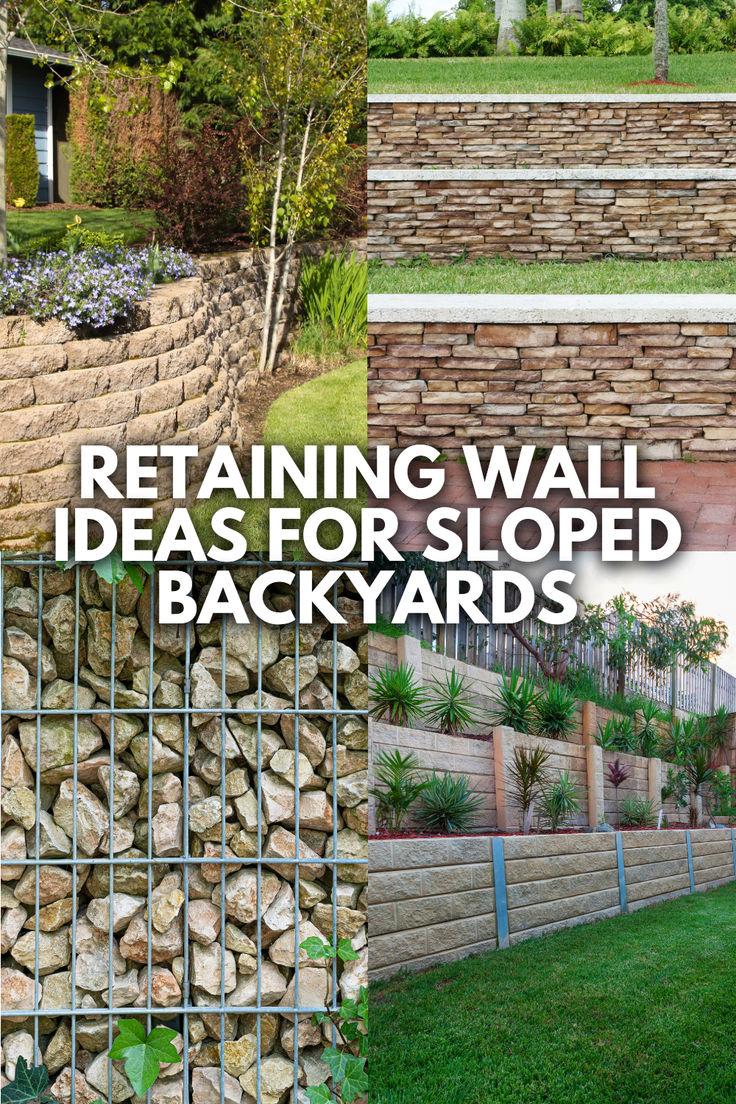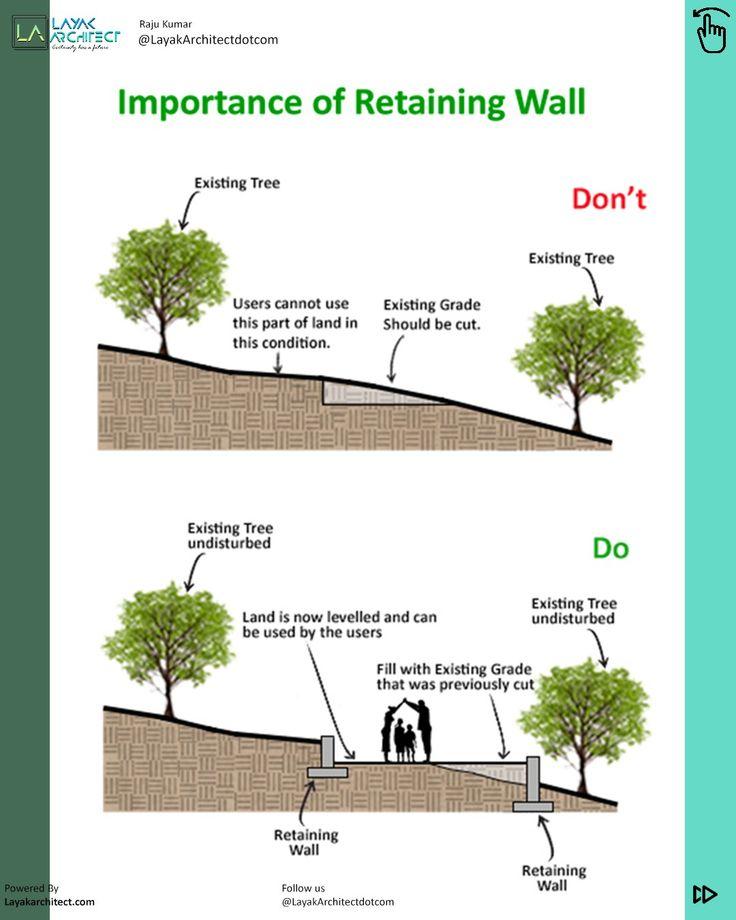



Table of Contents
- Introduction to Retaining Walls
- Types of Retaining Walls
- Materials Used in Retaining Wall Construction
- Design Considerations for Retaining Walls
- Construction Process
- Benefits of Retaining Walls
- Maintenance and Longevity
- Conclusion
- Faq's
Introduction to Retaining Walls
Retaining walls are structures designed to restrain soil to unnatural slopes. They are used to bound soils between two different elevations, often in areas of terrain possessing undesirable slopes or in situations where the landscape needs to be shaped severely and engineered for specific purposes like hillside farming or roadway overpasses. Beyond their functional role, retaining walls can significantly enhance the aesthetic appeal of a property by adding depth and dimension to the landscape.
Types of Retaining Walls
 Retaining Walls, Pinterest
Retaining Walls, Pinterest
Understanding the different types of retaining walls is essential for selecting the appropriate design and construction method for a specific application. Each type has its own advantages and is suited for different site conditions and structural requirements.
1. Gravity Retaining Walls
Gravity retaining walls rely solely on their weight and mass to resist the pressure from the soil behind them. They do not require reinforcement and are typically constructed using heavy materials.
Key Features:
- Constructed from concrete, stone, brick, or masonry
- Uses its own weight to counteract lateral earth pressure
- Best suited for walls up to 3 meters or 10 feet in height
- Can be built as dry-stacked or mortared walls for added strength
- Simple construction but requires a strong foundation for stability
Advantages:
- Cost effective for smaller walls
- Aesthetically versatile and blends well with landscapes
- Requires minimal reinforcement or structural components
Disadvantages:
- Not ideal for very tall walls due to weight limitations
- Requires a deep foundation to support the mass effectively
2. Cantilevered Retaining Walls
Cantilevered retaining walls use leverage and reinforcement to hold back soil. These walls consist of a vertical stem and a horizontal base slab that prevents overturning.
Key Features:
- Constructed from reinforced concrete
- Comprises a heel that extends under the backfill and a toe that extends forward for stability
- Ideal for retaining walls up to 6 meters or 20 feet in height
- Requires steel reinforcement to handle bending forces
Advantages:
- Uses less material than gravity walls for the same height
- Provides excellent stability through reinforcement
- Suitable for commercial and infrastructure projects
Disadvantages:
- Requires proper engineering calculations
- More complex construction process
- If not designed properly, it may fail due to soil pressure
3. Sheet Pile Retaining Walls
Sheet pile walls are thin walls driven deep into the ground to resist lateral soil pressure. They are commonly used in coastal areas, riverbanks, and urban spaces where space is limited.
Key Features:
- Made from steel, vinyl, wood, or composite materials
- Typically one third above ground and two thirds below for stability
- Can be anchored with tie backs for additional support
- Effective in soft soil and waterlogged areas
Advantages:
- Ideal for tight spaces where excavation is difficult
- Quick and cost effective installation
- Reusable materials especially for temporary applications
Disadvantages:
- Not suitable for hard or rocky soils
- May require corrosion resistant materials in wet environments
- Limited height capacity unless anchored
4. Anchored Retaining Walls
Anchored retaining walls use cables or rods anchored into the rock or soil behind the wall for additional stability. These are used for high load applications where space is limited.
Key Features:
- Uses anchors drilled into the soil or rock for extra support
- The anchors are tensioned to counteract lateral pressure
- Suitable for walls with significant height up to 15 meters or 50 feet
- Commonly used for steep slopes, highways, and bridge supports
Advantages:
- Supports very tall walls with minimal space requirements
- Provides superior stability in high load conditions
- Can be used in both temporary and permanent applications
Disadvantages:
- More expensive due to specialized anchoring equipment
- Requires technical expertise for installation
- Failure in anchor tensioning can lead to instability
5. Mechanically Stabilized Earth Walls
Mechanically stabilized earth walls use compacted soil reinforced with geogrids, geotextiles, or metal strips to enhance stability. These walls are widely used in highways, bridges, and large scale infrastructure projects.
Key Features:
- Constructed using layers of compacted soil with embedded reinforcement
- The facing can be concrete panels, wire mesh, or natural stone
- Flexible structure that can accommodate soil settlement
- Common in highway embankments, airport runways, and industrial zones
Advantages:
- Highly durable and can withstand heavy loads
- Works well in seismic prone areas due to flexibility
- Cost effective for large retaining walls
Disadvantages:
- Requires specialized materials and geotechnical analysis
- Not ideal for small scale residential applications
Also Read: Best Jewel Tones for Walls in 2025: Transform Your Interiors
Materials Used in Retaining Wall Construction
 How to build a Retaining Wall, Pinterest
How to build a Retaining Wall, Pinterest
The choice of materials for retaining wall construction affects both the functionality and aesthetics of the structure.
Concrete
Concrete is a versatile and durable material commonly used in retaining wall construction. It can be cast-in-place or precast, allowing for various design options. Concrete walls can be reinforced to increase their strength and are suitable for both gravity and cantilevered designs.
Stone and Masonry
Stone and masonry retaining walls offer a natural and timeless appearance. They are typically used in gravity wall designs and can be constructed using dry-stacked or mortared methods. These materials are durable and blend well with the surrounding landscape.
Timber
Timber retaining walls are cost-effective and relatively easy to construct. They are suitable for low-height applications and provide a rustic aesthetic. However, timber is susceptible to decay and may require treatment to withstand moisture and pests over time. Regular maintenance and potential replacement of deteriorated sections are necessary for longevity.
Brick
Brick retaining walls provide a classic and elegant appearance, making them popular for residential landscapes. They are often reinforced with concrete or steel for added strength. Brick walls require precise craftsmanship and proper drainage to prevent water buildup and pressure-related damage.
Gabions
Gabion retaining walls are made from wire mesh baskets filled with rocks or concrete debris. They are highly durable and permeable, allowing for effective drainage. Gabions are commonly used in erosion control applications and provide a rugged, industrial aesthetic.
Design Considerations for Retaining Walls
The effectiveness of a retaining wall depends on several design considerations, including soil type, drainage, load-bearing capacity, and aesthetic integration. A well-designed retaining wall enhances both structural integrity and visual appeal while preventing potential failures due to soil pressure, water accumulation, or poor construction practices.
 Retaining Wall Ideas, Pinterest
Retaining Wall Ideas, Pinterest
1. Soil Analysis
Understanding the soil properties is crucial before constructing a retaining wall. Different soil types exert varying levels of pressure on the wall, affecting its stability and performance.
- Clayey soils tend to expand when wet and contract when dry, exerting high lateral pressure on retaining walls. Proper reinforcement and drainage solutions are necessary to prevent damage.
- Sandy soils have better drainage properties, reducing hydrostatic pressure, but they have lower cohesion, meaning they may not hold together well without reinforcement.
- Rocky soils provide excellent stability and support for retaining walls but can make excavation and construction more challenging.
- Loamy soils, which are a mixture of sand, silt, and clay, offer good stability and drainage, making them ideal for retaining walls.
Key considerations for soil analysis:
- Conducting a geotechnical survey to determine soil composition and pressure
- Ensuring the soil has adequate bearing capacity to support the wall's weight
- Adjusting the retaining wall design based on the soil's expansion and contraction characteristics
2. Drainage Solutions
Proper drainage is essential to prevent water from accumulating behind the retaining wall, which can increase pressure and lead to structural failure. When water gets trapped, it exerts hydrostatic pressure, which can cause cracks, bulging, or even collapse of the wall.
Effective drainage solutions:
- Weep holes are small openings near the bottom of the wall that allow trapped water to escape, reducing pressure.
- Gravel backfill helps facilitate water movement and prevents soil from clogging drainage systems.
- Perforated drainage pipes placed at the base of the wall help redirect excess water away from the structure.
- Drainage membranes made of geotextile fabrics can be installed to improve water filtration and prevent soil erosion behind the wall.
- Sloping the ground surface behind the retaining wall helps direct water runoff away from the structure.
Key considerations for drainage:
- Ensuring proper grading and sloping to direct water flow
- Using free-draining materials like crushed stone or gravel instead of compacted soil
- Checking for clogging in weep holes or drainage pipes to maintain efficiency
3. Load Bearing Capacity
Retaining walls must be designed to withstand not just the weight of the soil but also additional loads from structures, vehicles, or foot traffic above the wall. Failing to account for these loads can result in wall tilting, cracking, or collapsing over time.
Factors affecting load bearing capacity:
- Earth pressure increases with wall height and must be considered in the design
- Live loads include additional weight from vehicles, buildings, decks, or heavy landscaping elements above the wall
- Seismic loads are a concern in earthquake-prone areas where retaining walls must be designed to withstand ground movement and prevent structural failure
- Wind loads affect tall retaining walls in open spaces, requiring reinforcement to handle wind pressure
Reinforcement methods for load support:
- Steel reinforcements such as rebar embedded in concrete to improve strength and durability
- Tiebacks or anchors that extend into the soil or rock behind the wall to enhance stability
- Counterforts, which are vertical supports attached to the wall to distribute pressure evenly
- Proper foundation depth to ensure the wall does not shift or settle over time
4. Aesthetic Integration
Retaining walls should complement the landscape and architectural style of the property while maintaining functionality. Incorporating design elements can make the wall visually appealing and blend seamlessly with the surroundings.
Ways to enhance the aesthetic appeal of retaining walls:
- Using decorative finishes such as textured concrete, natural stone, or brick for a visually appealing surface
- Integrating plants and greenery by creating stepped or terraced retaining walls that allow for vegetation growth
- Adding lighting elements to improve nighttime visibility and create an attractive outdoor space
- Choosing colors and materials that match the existing landscape or building structures
- Incorporating curves or varying heights in the design to make the wall appear more natural and less industrial
Key considerations for aesthetic integration:
- Selecting materials that complement the property's design
- Ensuring the wall blends well with the natural environment
- Choosing low maintenance design elements that retain their appeal over time
Also Read: Shear Walls in Construction: Essential for Structural Stability and Safety
Construction Process
 Importance of Retaining wall, Pinterest
Importance of Retaining wall, Pinterest
The construction of a retaining wall follows several crucial steps to ensure durability and effectiveness.
Site Preparation
- The site is cleared of debris and vegetation.
- Excavation is carried out to create a stable foundation.
Foundation Laying
- A solid foundation, often made of compacted gravel or concrete, is laid to support the wall.
- The foundation depth depends on the wall height and soil conditions.
Wall Assembly
- For stone or masonry walls, individual blocks are carefully placed and aligned.
- Reinforcement, such as steel bars, is added where necessary.
- In the case of poured concrete walls, formwork is set up before pouring the concrete.
Backfilling and Compaction
- The area behind the wall is backfilled with gravel or other drainage-friendly materials.
- Each layer is compacted to prevent settling and maintain wall stability.
Benefits of Retaining Walls
Retaining walls offer both functional and aesthetic advantages in landscaping and construction projects.
Erosion Control
By stabilizing slopes, retaining walls prevent soil erosion caused by wind and water.
Flood Prevention
Properly designed retaining walls help control water runoff and reduce the risk of flooding in low-lying areas.
Enhanced Usable Space
Retaining walls create level areas on sloped land, making it possible to build gardens, patios, and driveways.
Aesthetic Appeal
With a variety of materials and designs available, retaining walls can enhance the beauty of outdoor spaces.
Also Read: Cavity Walls: An Insight into Construction, Advantages, and Applications
Maintenance and Longevity
Regular maintenance ensures the longevity and effectiveness of retaining walls.
Regular Inspections
- Check for signs of cracking, tilting, or bulging.
- Inspect drainage outlets to ensure they are not clogged.
Repair Strategies
- Minor cracks can be sealed with concrete or epoxy.
- Significant structural damage may require professional reinforcement or reconstruction.
Longevity Factors
- Choosing high-quality materials enhances durability.
- Proper construction techniques, including adequate drainage, reduce the risk of failure.
Conclusion
Retaining walls play a crucial role in landscaping, erosion control, and structural support. They are available in various designs and materials, each with its own advantages. Proper planning, construction, and maintenance ensure that these walls remain effective and aesthetically pleasing for years to come. Whether for residential gardens or large infrastructure projects, retaining walls provide both practical and visual benefits, making them an essential component of modern construction.
explore further
Latest from Editorials
More from Publications
Resources
Dwello, for every home buyer, is a way to go from 'I feel' to 'I know', at no extra cost.




